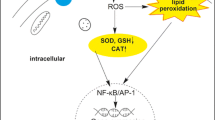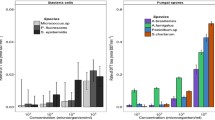Abstract
Biocides are added to biodiesels to inhibit and remove microbial growth. The effects of 5-chloro-2-methyl-4-isothiazolin-3-one (CMIT), a candidate biodiesel biocide, were studied using freshly isolated rat alveolar macrophages (AM) and NR8383 cell line. CMIT markedly inhibited phagocytic oxidative burst as measured by zymosan-induced chemiluminescence, and cellular cytokine secretion as measured by zymosan-induced TNF-α secretion. The 50% inhibition concentration (LC50) for CMIT was 0.002–0.004 mM for both cellular functions. AM exposed to CMIT for as little as 2 min showed markedly inhibited functions that persisted for at least 5 h. Sodium metabisulfite was able to partially neutralize the inhibitory activity of CMIT. Cysteine and glutathione, when present at a molar ratio of 2–1 or higher against CMIT, were effective neutralizers, while serine, histidine, alanine, and albumin were without effect. When the AM testing system was used to compare the toxicity of CMIT against three other candidate biodiesel biocides, methylene dithiocyanate (MDC) was found to be of comparable toxicity to CMIT, 2-methyl-4-isothiazolin-3-one (MIT) was much less toxic, and dimethyl acetylenedicarboxylate (DMAD) was non-toxic. Because AM is among the first cell-type exposed to inhaled biodiesel aerosols, the result suggested that CMIT present in biodiesel may produce respiratory effects, and further investigations including animal studies are warranted.







Similar content being viewed by others
Notes
Luminol is not readily soluble in incubation mixtures. The following procedure ensures complete solubilization. Luminol (17.7 mg) in 10 ml DMEM at 37 oC was sonicated to a fine suspension using a probe sonicator (Ultrasonic Processor, Cole-Parmer Instrument C., IL., USA). One volume of the suspension was added slowly to 9 volume of DMEM solution at 37 oC with vigorous mixing.
References
Adler PR, Del Grosso SJ, Parton WJ (2007) Life-cycle assessment of net greenhouse-gas flux for bioenergy cropping systems. Ecol Appl 16:675–691
Allen RC, Loose LD (1976) Phagocytic activation of a luminol-dependent chemiluminescence in rabbit alveolar and peritoneal macrophages. Bicohem Biophys Res Commun 69:245–252
Alvarez-Sánchez R, Basketter D, Pease C, Lepoittevin J-P (2003) Studies of chemical selectivity of hapten, reactivity, and skin sensitization potency. 3. Synthesis and studies on the reactivity toward model nucleophiles of the 13C-labeled skin sensitizers, 5-chloro-2-methylisothiazol-3-one (MCI) and 2-methylisothiazol-3-one (MI). Chem Res Toxicol 16:627–636
Bohn S, Niederer M, Brehm K, Bircher AJ (2000) Airborne contact dermatitis from methylchloroisothiazolinone in wall paint. Abolition of symptoms by chemical allergen inactivation. Contact Derm 42:196–201
Botham PA, Hilton J, Evans CD et al (1991) Assessment of the relative skin sensitizing potency of 3 biocides using the murine local lymph node assay. Contact Dermat 25:172–177
Bourke SJ, Convery RP, Stenton SC et al (1997) Occupational asthma in an isothiazolinone manufacturing plant. Thorax 52:746–748
Brito JM, Belotti L, Toledo AC et al (2010) Acute cardiovascular and inflammatory toxicity induced by inhalation of diesel and biodiesel exhaust particles. Toxicol Sci 116:67–78
Bruze M, Dahlquist I, Gruvberger B (1989) Contact allergy to dichlorinated methylsiothiazolinone. Contact Derm 20:219–220
Castranova V, Bowman L, Reasor MJ et al (1985) The response of rat alveolar macrophages to chronic inhalation of coal dust and/or diesel exhaust. Environ Res 36:405–419
Chapman JS, Diehl MA (1995) Methylcholoroisothiazolone-induced growth inhibition and lethality in Escherichia coli. J Appl Bacteriol 78:134–141
Collier PJ, Ramsey A, Waigh RD et al (1990a) Chemical reactivity of some isothiazolone biocides. J Appl Bacteriol 69:578–584
Collier PJ, Ramsey AJ, Austin P, Gilbert P (1990b) Growth inhibitory and biocidal activity of some isothiazolone biocides. J Appl Bacteriol 69:569–577
Connor TH, Tee PG, Afshar M, Connor KM (1996) Mutagenicity of cosmetic products containing Kathon. Environ Mol Mutagen 28:127–132
Denyer SP (1995) Mechanisms of action of antibacterial biocides. Int Biodeterior Biodegradation 227–245
Du S, McLaughlin B, Pal S, Aizenmean E (2002) In vitro neurotoxicity of methylisothiazolinone, a commonly used industrial and household biocide, proceeds via a zinc and extracellular signal-regulated kinase mitogen-activated protein kinase-dependent pathway. J Neurosci 22:7408–7416
Finch GL, Hobbs CH, Blair LF et al (2002) Effects of subchronic inhalation exposure of rats to emissions from a diesel engine burning soybean oil-derived biodiesel fuel. Inhal Toxicol 14:1017–1048
Forman HJ, Thomas MJ (1986) Oxidant production and bactericidal activity of phagocytes. Ann Rev Physiol 48:669–680
Ghio AJ, Meng ZH, Hatch GE, Costa DL (1997) Luminol-enhanced chemiluminescence after in vitro exposures of rat alveolar macrophages to oil fly ash is metal dependent. Inhal Toxicol 9:255–271
Ginn TR, Johnson MB, LaBolle EM et al (2009) Experimental plan for Tier II evaluation of biodiesel––1st revision, 9 March, 2009. UC Davis. http://www.arb.ca.gov/fuels/multimedia/031209TierIIrev.pdf
Gruvberger B, Bruze M (1998) Can chemical burns and allergic contact dermatitis from higher concentrations of methylchloroisothiazolinone/methylisothiazolinone be prevented? Am J Contact Dermat 9:11–14
Gwinn MR, Vallyatham V (2006) Respiratory burst: role in signal transduction in alveolar macrophages. J Toxicol Environ Health Part B 9:27–39
Hatch GE, Gardner DE, Menzel DB (1978) Chemiluminescence of phagocytic cells caused by N-formylthionyl peptides. J Exp Med 147:182–195
Hatch GE, Slade R, Stead AG, Graham JA (1986) Species comparison of acute inhalation toxicity of ozone and phosgene. J Toxicol Environ Health 19:43–53
He K, Huang J, Lagenaur CF, Aizeman E (2006) Methylisothiazolinone, a neurotixic biocide, disrupts the association of Src family tyrosine kinase with focal adhesion kinase in developing cortical neurons. J Pharmacol Exp Ther 317:1320–1329
Helmke RJ, Boyd RL, German VF, Mangos JA (1987) From growth factor dependence to growth factor responsiveness: the genesis of an alveolar macrophage cell line. In Vitro Cell Dev Biol 23:567–574
Helmke RJ, German VF, Mangos JA (1989) A continuous alveolar macrophage cell line: comparisons with freshly derived alveolar macrophages. In Vitro Cell Dev Biol 25:44–48
Holt PG, Strickland DH, Wikström ME, Jahnsen FL (2008) Regulation of immunological homeostasis in the respiratory tract. Nat Rev Immunol 8:142–152
Kawasaki H, Onuki R, Suyama ER, Taira K (2002) Identification of gene that function in the TNF-α-mediated apoptotic pathway using randomized hybrid ribozyme libraries. Nat Biotechnol 20:376–380
Kemp WH (2006) Biodiesel. Basics and beyond. A comprehensive guide to production and use for home and farm. Aztext Press Tamworth, Ontario
Lantz RC, Parliman G, Chen GJ, Carter DE (1994) Effect of arsenic exposure on alveolar macrophage function. I. Effect of soluble As (III) and As (V). Environ Res 67:183–195
Ma JYC, Barger MW, Kriech AJ, Castranova V (2000) Effects of asphalt fume condensate exposure on acute pulmonary responses. Arch Toxicol 74:452–459
McCormick RL (2007) The impact of biodiesel on pollutant emissions and public health. Inhal Toxicol 19:1033–1039
Miles PR, Lee P, Trush MA, Van Dyke K (1977) Chemiluminescence associated with phagocytosis of foreign particles in rabbit alveolar macrophages. Life Sci 20:165–170
Miles PR, Castranova V, Lee P (1978) Reactive forms of oxygen and chemiluminescence in phagocytizing rabbit alveolar macrophages. Am J Physiol 235:C103–C108
Mizgerd JP (2002) Molecular mechanisms of neutrophil recruitment elicited by bacteria in the lungs. Semin Immunol 14:123–132
Morley JO, Oliver AJ, Charlton MH (1998) Theoretical studies on the biocidal activity of 5-chloro-3-isothiazolone. J Mol Struct 429:103–110
Poon R, Chu I, Valli VE et al (2007) Effects of three biodiesels and a low sulphur diesel in male rats––A pilot 4-week oral study. Food Chem Toxicol 45:1830–1837
Poon R, Valli VE, Rigden R et al (2009) Short-term oral toxicity of three biodiesels and an ultra-low sulphur diesel in male rats. Food Chem Toxicol 47:1416–1424
Potter DW, Hazelton GA (1995) Evaluation of auricular lymph node cell proliferation in isothiazolone-treated mice. Fundam Appl Toxicol 24:165–172
Sato M, Sano H, Iwaki D et al (2003) Direct binding of toll-like receptor 2 to zymosan, and zymosan-induced NFκB activation and TNF-α secretion are down-regulated by lung collectin surfactant protein A. J Immunol 171:417–425
Singh T, Kreber B, Singh A et al (2006) Microscopic, biochemical and physiological assessment of the effect of methylene bisthiocyanate on the sapstain fungus Ophiostoma floccosum. Eur J Plant Pathol 114:317–328
US EPA (2002) A comprehensive analysis of biodiesel impacts on exhaust emissions. Draft technical report. Office of transportation and air quality. US environment protection agency. EPA-420-P-02-001
US EPA (2009) EPA lifecycle analysis of greenhouse gas emission from renewable fuels. Office of transportation and air quality. US environment protection agency. EPA-420-F-09-024
Videla LA, Correa L, Rivera M, Sir T (1993) Zymosan-induced luminol-amplified chemiluminescence of whole blood phagocytes in experimental and human hyperthyroidism. Free Rad Biol Med 14:669–675
Williams TM (2007) The mechanism of action of isothiazolone biocides. Power Plant Chem 9:14–22
Yamamoto K, Johnston Jr. RB (1984) Dissociation of phagocytosis from stimulation of the oxidative metabolic burst in macrophages. J Exp Med 159:405–416
Young S-H, Ye J, Frazer DG et al (2001) Molecular mechanism of tumor necrosis factor-α production in 1 → 3-β-Glucan (Zymosan)-activated macrophages. J Biol Chem 276:20781–20787
Zhang H, Park Y, Wu J et al (2009) Role of TNF-α in vascular dysfunction. Clin Sci 116:219–230
Acknowledgments
We wish to thank Ka Lei Ku Karen Leingartner and Brita Nadeau for excellent technical assistance. This work was supported by the Canadian Clean Air Research Agenda (CARA) and by the Canadian Program of Energy Research and Development (PERD).
Author information
Authors and Affiliations
Corresponding author
Rights and permissions
About this article
Cite this article
Poon, R., Rigden, M., Edmonds, N. et al. Effects of 5-chloro-2-methyl-4-isothiazolin-3-one and other candidate biodiesel biocides on rat alveolar macrophages and NR8383 cells. Arch Toxicol 85, 1419–1427 (2011). https://doi.org/10.1007/s00204-011-0689-y
Received:
Accepted:
Published:
Issue Date:
DOI: https://doi.org/10.1007/s00204-011-0689-y




